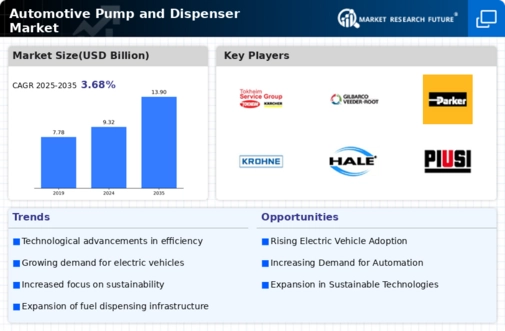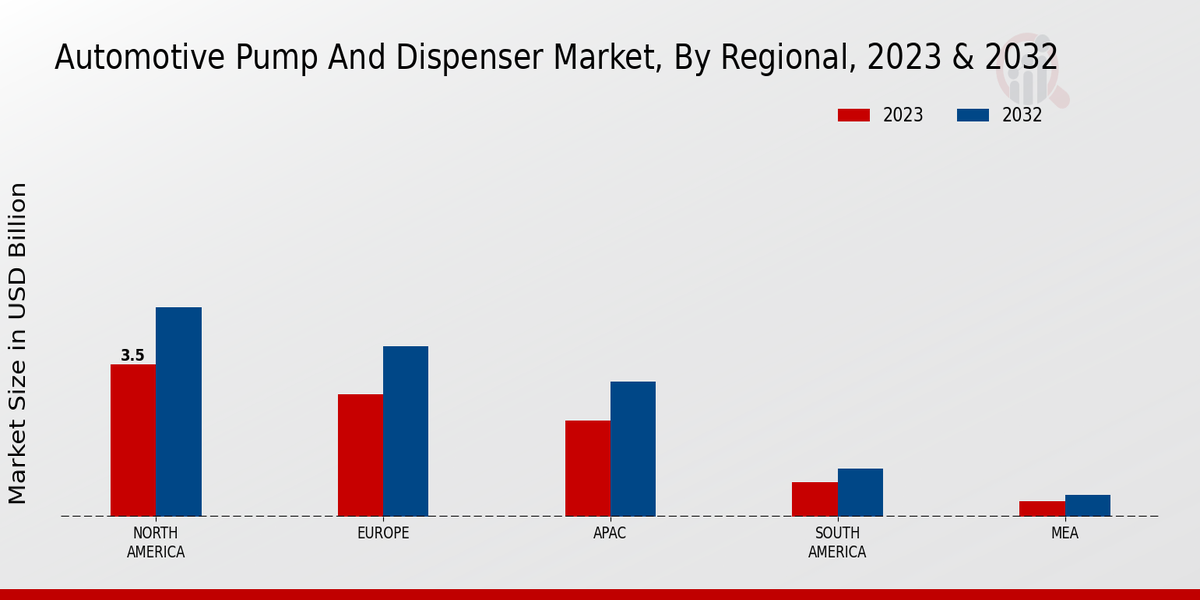Market Growth Projections
The Global Automotive Pump and Dispenser Market Industry is projected to experience substantial growth over the coming years. With a market value of 9.32 USD Billion in 2024, the industry is on track to reach 13.9 USD Billion by 2035. This growth trajectory indicates a robust demand for automotive pumps and dispensers, driven by factors such as technological advancements, regulatory support, and the increasing adoption of electric vehicles. The anticipated CAGR of 3.68% from 2025 to 2035 further underscores the market's potential, reflecting the ongoing evolution and adaptation of the automotive sector to meet changing consumer needs and environmental standards.
Growing Demand for Fuel Efficiency
The Global Automotive Pump and Dispenser Market Industry experiences a surge in demand for fuel-efficient vehicles, driven by rising fuel prices and environmental concerns. As consumers increasingly prioritize fuel economy, automotive manufacturers are compelled to innovate and integrate advanced pump and dispenser technologies. This trend is reflected in the projected market value of 9.32 USD Billion in 2024, indicating a robust growth trajectory. Enhanced fuel efficiency not only reduces operational costs for consumers but also aligns with global sustainability initiatives, thereby fostering a favorable environment for the adoption of advanced automotive pumps and dispensers.
Increase in Electric Vehicle Adoption
The rise in electric vehicle (EV) adoption is reshaping the Global Automotive Pump and Dispenser Market Industry. As more consumers transition to EVs, the demand for specialized charging dispensers is expected to grow. This shift presents opportunities for manufacturers to diversify their product offerings and invest in the development of innovative charging solutions. The increasing focus on sustainability and the reduction of carbon footprints further accelerates this trend. Consequently, the market is poised for transformation, with the potential for new revenue streams as the automotive landscape evolves towards electrification.
Regulatory Support for Emission Reduction
Regulatory frameworks aimed at reducing vehicle emissions significantly influence the Global Automotive Pump and Dispenser Market Industry. Governments worldwide are implementing stringent emission standards, compelling manufacturers to adopt cleaner technologies. This regulatory push not only promotes the development of advanced pump and dispenser systems but also encourages investment in research and development. As a result, the market is likely to witness sustained growth, with a projected CAGR of 3.68% from 2025 to 2035. Compliance with these regulations is essential for manufacturers to remain competitive and meet consumer expectations for environmentally friendly vehicles.
Technological Advancements in Pump Systems
Technological advancements play a pivotal role in shaping the Global Automotive Pump and Dispenser Market Industry. Innovations such as electronic fuel pumps and smart dispensers enhance performance and reliability, catering to the evolving needs of consumers and manufacturers alike. The integration of IoT technology into dispensers allows for real-time monitoring and data analytics, improving operational efficiency. As these technologies become more prevalent, they are expected to drive market growth, contributing to an anticipated market value of 13.9 USD Billion by 2035. This evolution underscores the importance of continuous innovation in maintaining competitiveness within the industry.
Expansion of Automotive Aftermarket Services
The expansion of automotive aftermarket services significantly impacts the Global Automotive Pump and Dispenser Market Industry. As vehicle ownership increases globally, the demand for maintenance and repair services also rises. This trend drives the need for high-quality pumps and dispensers in the aftermarket sector, as consumers seek reliable and efficient solutions for their vehicles. The aftermarket segment is expected to contribute substantially to market growth, with manufacturers focusing on providing durable and innovative products. This shift not only enhances customer satisfaction but also reinforces the importance of aftermarket services in sustaining the overall automotive market.













